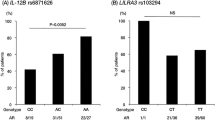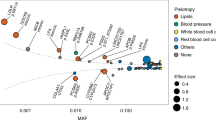Abstract
Coronary artery disease (CAD) and stroke are the major health problems in many countries because of their increasing prevalence and high mortality. It is well known that CAD and stroke are based on atherosclerosis and shared environmental and genetic risk factors. Recently, an association of a functional sequence variation −154G>A in the angiotensin receptor-like 1 (AGTRL1) with a susceptibility to stroke was reported. In this study, we investigated a total of 1479 CAD cases and 2062 controls from the Japanese and Korean populations to validate the association of AGTRL1 with CAD. However, we obtained no evidence of the association in both the Japanese (odds ratio (OR)=0.95, 95% confidence interval (CI); 0.82–1.10, P=0.47, allele count model) and Korean (OR=0.90, 95% CI; 0.77–1.05, P=0.18, allele count model) populations. In addition, there was no trend of association between the risk allele and severity of coronary atherosclerosis. These data suggested that AGTRL1 did not contribute much to the atherosclerosis of the coronary artery.
Similar content being viewed by others
Introduction
Coronary artery disease (CAD) is caused by the thrombotic occlusion of coronary arteries and becomes a major health problem in many countries. CAD is mainly based on the atherosclerosis of the coronary artery and often manifests with sudden chest pain because of reversible (angina pectoris, AP) or irreversible (myocardial infarction, MI) ischemia in the heart caused by the decreased blood flow in the coronary arteries.
Stroke, in particular, ischemic stroke is caused by the thrombotic occlusion of cerebral arteries associated with atherosclerosis, which shares at least in part pathogenic mechanisms and risk factors such as smoking, hypertension, hypercholesterolemia and diabetes mellitus with CAD,1 and recent genome-wide association studies have identified polymorphism on chromosome 9p21 as a common risk variant for both stroke and CAD.2, 3, 4 In addition, Hata et al.5 recently reported that angiotensin receptor-like 1 (AGTRL1) was highly expressed in the cardiovascular system and the central nervous system and that a functional sequence variation −154G>A (rs9943582) in the 5′-anking region of AGTRL1 was associated with the stroke in Japanese; the G allele frequencies were 0.721 and 0.666 in patients and controls, respectively (OR=1.30, 95% CI; 1.14–1.47, P=6.6 × 10−5).
Although AGTRL1 should be a strong candidate for CAD risk considering that CAD shares risk factors with stroke, the relationship between the AGTRL1 genetic variant and CAD has not been tested. To address this issue, we investigated the association of AGTRL1-154G>A with CAD in two East Asian populations, Japanese and Korean.
Methods
Subjects
A total of 1479 CAD cases and 2062 control subjects from the Japanese and Korean populations were the subjects as reported earlier.6, 7, 8 Briefly, the Japanese panels were composed of CAD cases (n=621) and controls (n=1275). The cases included 575 MI cases and 46 AP cases, whereas the controls comprised healthy individuals selected at random (n=539) and healthy donor-derived B-cell lines obtained from the Japan Health Sciences Foundation (n=736). The Korean subjects consisted of CAD cases (n=858) and controls (n=693). The cases included MI cases (n=490) and AP cases (n=368), whereas healthy individuals selected at random (n=174) and cancer patients without ischemic heart diseases (n=519) consisted of controls. The diagnosis of CAD was based on the standard criteria as described earlier.9 Severity of coronary atherosclerosis was classified according to the number of coronary vessels with significant stenosis (angiographic luminal stenosis >50%) as 0, 1, 2 or 3 vessel disease, as described earlier.10 Informed consent was given from each participant and the study was approved by the Ethics Review Boards of Medical Research Institute of Tokyo Medical and Dental University, Kitasato University School of Medicine, Tokyo Metropolitan Geriatric Medical Center and Samsung Medical Center.
Genotyping
The AGTRL1 SNP −154G>A (rs9943582) was genotyped using the TaqMan SNP genotyping assay (Applied Biosystems, Foster City, CA, USA).
Statistical analysis
A statistical analysis for power and sample size computations of case–control design was performed using the PGA program (http://dceg.cancer.gov/bb/tools/pga)11 under the following conditions: disease allele frequency; 0.666, prevalence of CAD; 0.05, G allele odds risk; 1.30, type I error rate; 0.05. Frequencies of genotypes and alleles were compared between the cases and controls using a χ2-test. Strength of the association was expressed by odds ratio (OR). Meta-analysis was performed using a Mantel–Haenszel method. Significance of the association between the severity of coronary atherosclerosis and rs9943582 was examined by the Mann–Whitney U-test. When a P-value was less than 0.05, the association was considered to be significant.
Results and discussion
Clinical characteristics of the tested populations are shown in Table 1. Case–control studies were performed to validate the association of AGTRL1 −154G>A with CAD. Statistical power analyses of our study design to verify whether it could provide adequate powers in testing the association reported by Hata et al.4 indicated that the power was 95.2 and 94.0% in the Japanese and Korean populations, respectively.
As shown in Table 2, distributions of the AGTRL1 genotypes did not depart from the Hardy–Weinberg equilibrium in all the tested populations, and no significant association between the −154G allele and CAD was found in both the Japanese (OR=0.95, 95% CI; 0.82–1.10, P=NS) and Korean (OR=0.90, 95% CI; 0.77–1.05, P=NS) populations (Table 2). In addition, there were no significant differences in the −154G allele frequency between the MI and AP cases. When we performed a meta-analysis of the data from the Japanese and Korean panels, the association was not significant (OR=0.92, 95% CI; 0.83–1.03, P=NS). These observations strongly suggested that AGTRL1 −154G>A did not have a significant impact on the pathogenesis of CAD.
As both CAD and stroke are atherosclerotic vascular diseases, a possibility remained that AGTRL1 might be associated with the severity of coronary atherosclerosis. Therefore, we stratified the CAD cases by the number of significantly affected vessels, that is, zero, one, two, three vessel disease, and compared the frequency of −154G allele (Table 3). However, we found no trend of association between the −154G allele and the severity of coronary atherosclerosis in both the Japanese and Korean CAD (P=0.72 and P=0.84, respectively). Stratified analyses of CAD cases with classical risk factors including smoking, hypertension, hypercholesterolemia and diabetes mellitus also showed no trend of association between the −154G allele and any specific risk factors in the Japanese and Korean CAD (data not shown).
In conclusion, we found no significant association of the AGTRL1 polymorphism with CAD or the severity of coronary atherosclerosis. It was therefore unlikely that the AGTRL1 polymorphism contributed much to the development of CAD. Further analyses are required to clarify the relevance of AGTRL1 in the other atherosclerotic diseases.
References
Pasternak, R. C., Criqui, M. H., Benjamin, E. J., Fowkes, F. G., Isselbacher, E. M., McCullough, P. A. et al. Atherosclerotic Vascular Disease Conference: Writing Group I: epidemiology. Circulation 109, 2605–2612 (2004).
Wellcome Trust Case Control Consortium. Genome-wide association study of 14 000 cases of seven common diseases and 3000 shared controls. Nature 447, 661–78 (2007).
Matarin, M., Brown, W. M., Singleton, A., Hardy, J. A., Meschia, J. F. & ISGS investigators Whole genome analyses suggest ischemic stroke and heart disease share an association with polymorphisms on chromosome 9p21. Stroke 39, 1586–1589 (2008).
Gschwendtner, A., Bevan, S., Cole, J. W., Plourde, A., Matarin, M., Ross-Adams, H. et al. Sequence variants on chromosome 9p21.3 confer risk for atherosclerotic stroke. Ann. Neurol. 65, 531–39 (2009).
Hata, J., Matsuda, K., Ninomiya, T., Yonemoto, K., Matsushita, T., Ohnishi, Y. et al. Functional SNP in an Sp1-binding site of AGTRL1 gene is associated with susceptibility to brain infarction. Hum. Mol. Genet. 16, 630–639 (2007).
Hinohara, K., Nakajima, T., Takahashi, M., Hohda, S., Sasaoka, T., Nakahara, K. et al. Replication of association between a chromosome 9p21 polymorphism with coronary artery disease in Japanese and Korean populations. J. Hum. Genet. 53, 357–359 (2008).
Hinohara, K., Nakajima, T., Sasaoka, T., Sawabe, M., Lee, B. S., Ban, J. et al. Replication studies for the association of PSMA6 polymorphism with coronary artery disease in East Asian populations. J. Hum. Genet. 54, 248–251 (2009).
Hinohara, K., Nakajima, T., Yasunami, M., Houda, S., Sasaoka, T., Yamamoto, K. et al. Megakaryoblastic leukemia factor-1 gene in the susceptibility to coronary artery disease. Hum. Genet. (2009)doi: 10.1007/s00439-009-0698-6.
Hohda, S., Kimura, A., Sasaoka, T., Hayashi, T., Ueda, K., Yasunami, M. et al. Association study of CD14 polymorphism with myocardial infarction in a Japanese population. Jpn. Heart. J. 44, 613–622 (2003).
Kimura, A., Takahashi, M., Choi, B. Y., Bae, S. W., Hohta, S., Sasaoka, T. et al. Lack of association between LTA and LGALS2 polymorphisms and myocardial infarction in Japanese and Korean populations. Tissue Antigens 69, 265–269 (2007).
Menashe, I., Rosenberg, P. S. & Chen, B. E. PGA: Power calculator for case-control genetic association analyses. BMC Genetics. 9, 36 (2008).
Acknowledgements
We thank Drs Kouji Chida, Ken-ich Nakahara, Megumi Takahashi, Shigeru Houda and Michio Yasunami for their contributions in the initial course of the study. This study was supported in part by a Grant-in-Aid for Scientific Research from the Ministry of Education, Culture, Sports, Science and Technology of Japan, a grant for Japan–Korea collaboration research from the Japan Society for the Promotion of Science, and a grant for Joint Research Project under the Korea–Japan Basic Scientific Cooperation Program from the Korea Science and Engineering Foundation.
Author information
Authors and Affiliations
Corresponding author
Rights and permissions
About this article
Cite this article
Hinohara, K., Nakajima, T., Sasaoka, T. et al. Validation of the association between AGTRL1 polymorphism and coronary artery disease in the Japanese and Korean populations. J Hum Genet 54, 554–556 (2009). https://doi.org/10.1038/jhg.2009.78
Received:
Accepted:
Published:
Issue Date:
DOI: https://doi.org/10.1038/jhg.2009.78



